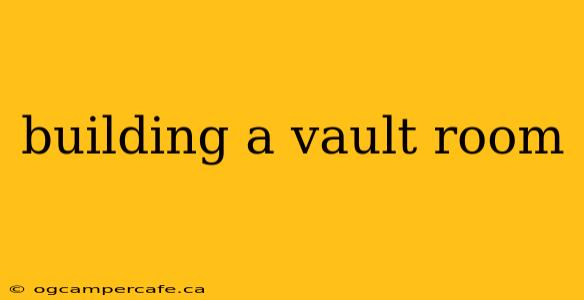Building a vault room isn't a weekend DIY project; it's a significant undertaking requiring careful planning, expert execution, and a substantial investment. This comprehensive guide delves into the crucial aspects of designing and constructing a secure vault room, from initial considerations to the final touches. Whether you're safeguarding precious valuables, sensitive documents, or critical data, understanding these steps is paramount.
Phase 1: Planning and Design – Laying the Foundation for Security
Before breaking ground (literally!), meticulous planning is essential. This phase involves several key decisions:
1. Defining Security Needs and Threat Assessment:
This is the cornerstone of your project. What are you protecting? What level of threat are you anticipating? A simple home safe won't suffice against a determined burglar, while a high-security bank vault requires far more robust construction. Consider factors like:
- Value and Irreplaceability: The higher the value and irreplaceability of your assets, the greater the security investment needed.
- Threat Level: Are you concerned about opportunistic theft, professional burglary, or even more extreme scenarios?
- Environmental Threats: Fire, flood, and seismic activity should all be factored into your design.
2. Choosing a Location:
The location significantly impacts the vault's security and construction. Ideal locations are:
- Discreet and Difficult to Access: Avoid highly visible locations or areas with easy access points.
- Structurally Sound: The surrounding structure must be able to support the weight of the vault and withstand potential attacks.
- Environmental Considerations: Minimize the risk of flooding, fire, or other environmental damage.
3. Determining Vault Size and Specifications:
The size of your vault will depend on the volume of items you need to secure. Consider:
- Internal Dimensions: Account for shelving, storage containers, and ease of access.
- Door Size and Type: Choose a door that meets your security needs and is appropriately sized for your assets. Consider materials like steel, concrete, or specialized composite materials.
- Environmental Control: Will you need climate control to maintain a stable temperature and humidity for your contents?
Phase 2: Construction – Bringing Your Vault Room to Life
This phase requires skilled professionals:
1. Foundation and Walls:
- Reinforced Concrete: A robust concrete foundation and walls are crucial. The thickness should be determined based on your threat assessment.
- Rebar Reinforcement: Steel rebar reinforcement significantly strengthens the concrete, making it more resistant to penetration.
- Seismic Considerations: In earthquake-prone areas, specific engineering is necessary to ensure the vault remains intact.
2. Vault Door Installation:
- Professional Installation: Vault doors are heavy and complex, requiring specialized installation by experienced technicians.
- Locking Mechanisms: Select high-security locking mechanisms, preferably with multiple locking points and advanced security features.
- Door Material: Choose a door material that matches your threat assessment—thicker steel for higher security.
3. Interior Fit-out:
- Shelving and Storage: Install appropriate shelving and storage solutions to optimize space and protect your contents.
- Environmental Control Systems: If required, integrate climate control systems to maintain optimal conditions.
- Security Systems Integration: This could include alarm systems, CCTV, motion detectors, and access control systems.
Phase 3: Completion and Ongoing Maintenance – Ensuring Long-Term Security
This final stage ensures your investment remains secure:
1. System Testing and Security Audits:
Thoroughly test all security systems to ensure they function correctly. Consider professional security audits to identify potential vulnerabilities.
2. Ongoing Maintenance:
Regular maintenance is vital for the longevity and security of your vault room. This includes inspecting the door, locking mechanisms, and security systems.
3. Emergency Procedures:
Develop and practice emergency procedures in case of fire, flood, or other unforeseen events.
Building a vault room is a complex project demanding expertise and significant investment. Prioritizing security planning, choosing the right professionals, and conducting regular maintenance are key to ensuring your assets remain safe and secure for years to come. Remember to always consult with security professionals and experienced contractors throughout the entire process.
